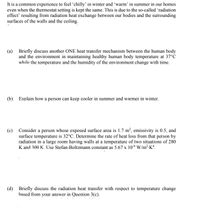
Introduction to Chemical Engineering Thermodynamics
8th Edition
ISBN: 9781259696527
Author: J.M. Smith Termodinamica en ingenieria quimica, Hendrick C Van Ness, Michael Abbott, Mark Swihart
Publisher: McGraw-Hill Education
expand_more
expand_more
format_list_bulleted
Concept explainers
Question

Transcribed Image Text:It is a common experience to feel 'chilly’ in winter and 'warm' in summer in our homes
even when the thermostat setting is kept the same. This is due to the so-called 'radiation
effect' resulting from radiation heat exchange between our bodies and the surrounding
surfaces of the walls and the ceiling.
(a) Briefly discuss another ONE heat transfer mechanism between the human body
and the environment in maintaining healthy human body temperature at 37°c
while the temperature and the humidity of the environment change with time.
(b) Explain how a person can keep cooler in summer and warmer in winter.
(c) Consider a person whose exposed surface area is 1.7 m², emissivity is 0.5, and
surface temperature is 32°C. Determine the rate of heat loss from that person by
radiation in a large room having walls at a temperature of two situations of 280
K and 300 K. Use Stefan-Boltzmann constant as 5.67 x 10-8 W/m²-K*.
(d) Briefly discuss the radiation heat transfer with respect to temperature change
hased from your answer in Question 3(c).
Expert Solution
This question has been solved!
Explore an expertly crafted, step-by-step solution for a thorough understanding of key concepts.
This is a popular solution
Trending nowThis is a popular solution!
Step by stepSolved in 5 steps with 4 images

Knowledge Booster
Learn more about
Need a deep-dive on the concept behind this application? Look no further. Learn more about this topic, chemical-engineering and related others by exploring similar questions and additional content below.Similar questions
- Example • The cylinder is made from aluminum with diameter and thickness of 5 cm and 1 cm respectively. The wall temperature in the inside of cylinder is 50°C, while the temperature of the air is 30°C. the coefficient of convection in the air is 10 W/m2-C. Calculate the heat loss from the cylinder per unit length! • Calculate the thickness of the insulation so heat loss from cylinder will decrease 50% of initial condition. Thermal conductivity of the isolator (k) : 0.5 W/m°C state.pptx 7 MB VIEW Tampilkan semuaarrow_forwardA copper electric wire of radius R, = 1 mm is isolated by a layer of PVC so that the outer radius of the wire Rg = 2 mm, as shown in Figure below. The wire exchanges heat with the air at 20°C according to a heat transfer coefficient h=20 W/m2°c: Given that : k=copper electrical conductivity=4.0 × 1070hm-'m¯! kpvc= PVC thermal conductivity = 0.3- m°C kco = copper thermal conductivity = 100 m°C %3D (amp/m)² And that the electrical heating source is given by : S, amp²s /kgm³ If the temperature (T,) on the outer surface (r = RG) is 25°C, what is the electrical current C (amp) that passes through this wire? Dont forget to state your hypothesis clearly. Hi, Could you please tell me what the book's name is? Thank you!arrow_forwardIn a movie theater in winter, 500 people are watching a movie. The heat losses through the walls, windows, and the roof are estimated to be 150,000 Btu/h. Determine if the theater needs to be heated or cooled.arrow_forward
Recommended textbooks for you
 Introduction to Chemical Engineering Thermodynami...Chemical EngineeringISBN:9781259696527Author:J.M. Smith Termodinamica en ingenieria quimica, Hendrick C Van Ness, Michael Abbott, Mark SwihartPublisher:McGraw-Hill Education
Introduction to Chemical Engineering Thermodynami...Chemical EngineeringISBN:9781259696527Author:J.M. Smith Termodinamica en ingenieria quimica, Hendrick C Van Ness, Michael Abbott, Mark SwihartPublisher:McGraw-Hill Education Elementary Principles of Chemical Processes, Bind...Chemical EngineeringISBN:9781118431221Author:Richard M. Felder, Ronald W. Rousseau, Lisa G. BullardPublisher:WILEY
Elementary Principles of Chemical Processes, Bind...Chemical EngineeringISBN:9781118431221Author:Richard M. Felder, Ronald W. Rousseau, Lisa G. BullardPublisher:WILEY Elements of Chemical Reaction Engineering (5th Ed...Chemical EngineeringISBN:9780133887518Author:H. Scott FoglerPublisher:Prentice Hall
Elements of Chemical Reaction Engineering (5th Ed...Chemical EngineeringISBN:9780133887518Author:H. Scott FoglerPublisher:Prentice Hall
 Industrial Plastics: Theory and ApplicationsChemical EngineeringISBN:9781285061238Author:Lokensgard, ErikPublisher:Delmar Cengage Learning
Industrial Plastics: Theory and ApplicationsChemical EngineeringISBN:9781285061238Author:Lokensgard, ErikPublisher:Delmar Cengage Learning Unit Operations of Chemical EngineeringChemical EngineeringISBN:9780072848236Author:Warren McCabe, Julian C. Smith, Peter HarriottPublisher:McGraw-Hill Companies, The
Unit Operations of Chemical EngineeringChemical EngineeringISBN:9780072848236Author:Warren McCabe, Julian C. Smith, Peter HarriottPublisher:McGraw-Hill Companies, The

Introduction to Chemical Engineering Thermodynami...
Chemical Engineering
ISBN:9781259696527
Author:J.M. Smith Termodinamica en ingenieria quimica, Hendrick C Van Ness, Michael Abbott, Mark Swihart
Publisher:McGraw-Hill Education

Elementary Principles of Chemical Processes, Bind...
Chemical Engineering
ISBN:9781118431221
Author:Richard M. Felder, Ronald W. Rousseau, Lisa G. Bullard
Publisher:WILEY

Elements of Chemical Reaction Engineering (5th Ed...
Chemical Engineering
ISBN:9780133887518
Author:H. Scott Fogler
Publisher:Prentice Hall


Industrial Plastics: Theory and Applications
Chemical Engineering
ISBN:9781285061238
Author:Lokensgard, Erik
Publisher:Delmar Cengage Learning

Unit Operations of Chemical Engineering
Chemical Engineering
ISBN:9780072848236
Author:Warren McCabe, Julian C. Smith, Peter Harriott
Publisher:McGraw-Hill Companies, The